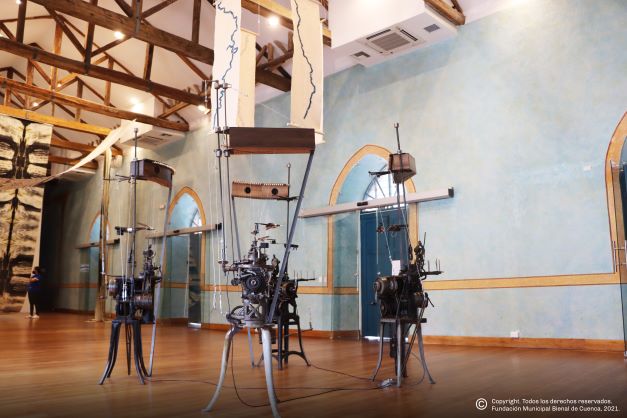
25.03.2022
Historian Alexandra Kennedy-Troya reviews the 15th Cuenca Biennial and its new approach to sustainability, climate emergency and its relationship between different species.
In June 2020, during the health crisis caused by the COVID19 pandemic, the Concert for the Biocene by the artist Eugenio Ampudia was presented at the Liceo de la Música de Barcelona in Spain. More than two thousand plants were “spectators”. According to literary scholar Javier Helgueta Manso, they were an “uprooted” audience that supplanted the exiled public at home. Ampudia thus denaturalizes the theatrical pact and the normative human communicative schemes by skipping their presence and listening. This concert performance, in Helgueta’s words, is more interesting for its symbolic impact than for its originality or ethical and aesthetic execution. The non-human (or de-localizing human) character proposed in this concert runs through the work of the guests invited to the 15th Cuenca Biennial in Ecuador (December, 2021 – February, 2022). The video recording of Ampudia’s Concert for the Biocene will be one of the pieces exhibited in this Biennial.

In this way, the concert is transmuted into the curatorial proposal elaborated by Spanish curator Blanca de la Torre, called Biennial of the Biocene: Change the green for blue. The curatorial discourse aims to build a new narrative of sustainability in relational equality between the different species and their environments. The proposal is based on three transversal axes: ancestral knowledge and other epistemologies, ecofeminisms and futuristic scenarios. As the curatorial discourse states, water becomes a special protagonist of the exhibition in the face of the climate emergency; the resistance to extractivist policies; the preservation of biodiversity; the care of the sea, land and air; and in the face of pollution and destruction of natural habitats. Cuenca, the host city, is crossed by four rivers, the water table is extremely high; extraordinary wetlands are very close, ancestral medicinal practices still persist, the borders between urban and rural practically do not exist; on the other hand, the high rate of femicides are resisted by local women’s activist groups, this among other things allow us to affirm that the relevance of the topic in the place of reception and in the current post-pandemic and now war times is/was unquestionable.

Juan Zamora, "A veces el océano vascula entre las hojas", 2021. Installation composed of plant leaves intervened with bioluminescence and ecological resin, drawings, sound and video. Image courtesy of the Cuenca Biennial.
We enter one of the main houses in the historic center, now In Arte Contemporáneo gallery. In an intricate colonial garden, practically untouched, we discover the fantastic world of bioluminescent plants by artist and biologist Juan Zamora. The installation A veces el océano vascula entre las hojas, allows us to understand the primal creation of things from the principles of association and duplication of molecules. By injecting light substances from the algae, the artist eliminates the greenness of the plants and makes them radiate in a different way. These natural “chemicals” are applied in the form of tiny watercolors of cosmic beings, whose poetics then resonate with us at every step.


The laboratory—science and art in unison—also concern Paúl Rosero. From my point of view, one of the most outstanding works of the Biennial, El Pensamiento de las Plantas, Capítulo 2 –Cuando despertó, el dinosaurio ya no estaba ahí. It is a kind of radiography of the future, a science fiction story that introduces us to the experimental process of a ghost fishing through fungi that consume synthetic waste in the sea off the coast of Esmeraldas, Ecuador. Speculative realism is translated into an archaeological cemetery of human excrement built with these wastes, from which strange, brassy sounds are emitted, demanding us to continue walking in this questioning underwater world.


Fabric and weaving move the spectator through the exhibition. To weave is to bind, religare—in spiritual terms—is visible in the works of some artists such as Tania Candiani’s Arpas de agua—Acquisition Prize—. She finds old industrial machines from a textile factory, which she then turns into sound harps, contrasting white banners embroidered in blue with the profile of the rivers that cross the city. These hang over the mechanical artifacts creating an indissoluble symphony between hand and machine, natural water and artifice. The flow of fluid, of sound, of movement, in harmony. Memories of the artifact, memories that are woven in time, that produce a symbolic re-reading of the objects and the subjects behind them. Pamela Cevallos—Paris Prize winner—with Corrientes de retorno, enters the world of archeology, through the current copy of centenary ceramics and the communities that reproduce them. She plays ironically with the famous huacos (Giants sculptures of Bahia). She points them out with bizarre colors, denaturalizes them so that they look at us questioningly from their distorted histories.


At the Cuenca Biennial, different works question the term “drug” imposed on substances such as Ayahuasca or San Pedro. These, consumed by the protectors of the community, become fundamental channels of dialogue between human, animal and vegetable natures, where the original knowledge of the world is found and from which has been extracted (perhaps better said stolen), as an unquestionable western science, the production of current medicines validated by the powerful medical societies in close relationship with the millionaire western pharmaceutical companies. The work of the digital artist Ursula Biemann—honorable mention—goes along these lines and more, creating a cosmic hologram from which a deep knowledge of shamans regarding intelligence in nature is validated. Complementarily, from the studies of DNA in the 50’s, we know about a unique code that interrelates us all and everything. Both learnings—shamanic and scientific—, allow Biemann to speak of a Mind in and from the jungle.


Comments
There are no coments available.